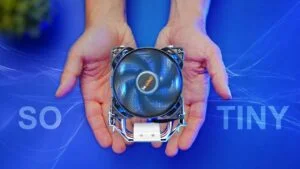Intel i9-10900K & i5-10600K Review & Benchmarks

Share:
It has been almost 10 months since the launch of AMD’s third-generation Ryzen processors, and those chips have been dominating Intel’s offerings. Intel was sitting there hoping that their Coffee Lake CPUs like the Core i9-9900K would compete against the best that AMD had to offer, but it wasn’t enough. What they are trying to do right now is push another 14nm refresh called Comet Lake, which is what we are reviewing today. Intel might not publicly admit it, but they know that their new desktop CPUs are in a really bad place right now. They are doing everything they possibly can to stop the bleeding until a new architecture and a new manufacturing process is ready.
Remember AMD had to go through this years ago, they had to last six years on 32nm until Ryzen arrived. And what’s really interesting is that this is the 6th year that Intel is on 14nm. However, let’s also not forget that the FX series from AMD was targeted towards a market that was more value-focused, and those buyers are easier to please than those looking for cutting edge performance. One of Intel’s major problems is nearly every single one of AMD’s third-generation Ryzen processors are on sale right now. This isn’t an official price cut, but it still makes things look very different right now than when Comet Lake was first announced a few weeks ago. Can Intel overcome these cheaper prices? We are about to find out. By the way, this review is going to be more benchmark focused, but if you are looking for more information about the architecture and about the processors that Intel has announced make sure to check out our Explained article, which covers all of these new Comet Lake CPUs.
Competing Against Price Cuts
Even though there are going to be almost two dozen new Comet Lake CPUs available today, Intel sent us only two of them. The flagship Core i9-10900K and the Core i5-10600K, a more affordable mid-range option. Both are completely unlocked for overclocking, but where they ended up against AMD is very interesting. The Core i9-10900K is replacing the Core i9-9900K with more cores and higher clock speeds, but with a price of $490 USD it’s going up against a pretty tough competitor in the Ryzen 9 3900X. That processor usually goes for about $500 USD, but lately I have been seeing it floating between $400-440 USD. It will be interesting to see if those prices continue and if they do Intel is going to be fighting an uphill battle against a processor that has an efficient manufacturing process, more threads, and a much lower price tag.
As for the i5-10600K, as a replacement for the i5-9600K it looks pretty good by offering double the number of threads and slightly higher frequencies. Technically it’s going head-to-head against the 6-core/12-thread 3600X, but through the miracle of sales that Ryzen chip is going for just $205 USD these days. That means the i5-10600K ends up almost hitting the same price as the 8-core/16-thread Ryzen 7 3700X, which used to hit the $330 USD mark but can now be found below $300 USD. Now there are a few things that I want to mention about these prices before going any further. First of all, sales don’t last forever, so the Ryzen 3000s might rise in cost, but I’m not entirely sure about that. Also, some of them are pretty old as far as processors go, and AMD did say that they will launch the Zen 3 this year, so until next gen Ryzen CPUs rollout this is the perfect opportunity to keep those prices low and really put the hurt on Intel. As for Intel prices, let’s just say that I will believe them when I see them online, so take that with a grain of salt.
So Many Turbo Modes
Another thing I want to talk about is clock speeds, because on these new CPUs there’s a ton of variables when it comes to hitting Intel’s advertised frequencies. This is especially true with the Core i9-10900K. It actually has a ton of different frequencies, many of which you have probably seen on past Intel CPUs and all of them are dependent on variables like power, temperatures, and workload. There is a base frequency of 3.7GHz, and the usual Turbo Boost 2.0 which can bring a single core up to 5.1GHz. Next Turbo Boost 3.0 then enhances that capability by finding the fastest core and boosting that one even further to 5.2GHz in single-threaded workloads. Then there is the All Core Turbo frequency of 4.8GHz, which is the theoretical maximum sustained clock speed when all cores and threads are fully loaded. The new addition here is what Intel calls Thermal Velocity Boost and it takes frequencies to the next level, but only in very short bursts on your CPUs two best cores and only under strict circumstances. It will only be enabled if the CPU’s temperature is 70°C or less, and the CPU’s power package allows for higher speeds.
Speaking of those boost levels, I should also mention that each motherboard manufacturer has a different way of addressing them and many tend to operate outside of Intel’s predefined limits. For example, ASUS automatically enables their multi-core enhancement, which artificially enhances scores. Meanwhile, the latest version of Gigabyte’s BIOS extends power limits so these new CPUs will operate at higher power thresholds for longer periods of time. We always stick to Intel’s predefined stock settings, so let’s see what that translates to in terms of clock speeds.
First of all, you can see here that the two best cores on our i9-10900K are Core #4 and Core #5. Those are the only ones that hit 5.3GHz on a single core. By charting temperatures and clock speeds over time on a single core, you can see that the core hitting that 5.3GHz mark, but only occasionally. This might only tell half the story though since our 1 second polling rate likely isn’t picking up sub-millisecond changes in speed, so the 10900K could be hitting the higher ratio more often than we see. However, if you look towards the center of the chart, temperatures on this core rose a bit, which likely meant another Windows process started eating up some resources since temperatures stayed below 60°C and package power was super low as well. Technically, the frequency should have stayed between 5.1GHz and 5.3GHz, but it didn’t. Honestly, this just shows just how damn picky Intel’s boost algorithm is.
What about in multi-core workloads like Maya render? Well starting things off with a default fan speed profile on the ASUS motherboard and a Noctua NH-U12S things got interesting. Temperatures spiked before the heatsink fans could catch up, but then they leveled out way under Intel’s 70°C threshold for Thermal Velocity Boost. As for clock speeds, well the first 30 seconds shows clocks hitting really impressive speeds as Intel’s short duration power limit gives a more relaxed setting, but that also causes the temperature to increase. Then Intel’s long duration power limits sets in and frequencies and temperatures nosedive, with the 10900K varying between 4.1GHz and 4.2GHz. But what happens when we add more cooling? Will the chips stay at higher speeds? Well I stuck two fans running at a 100% on the Noctua NH-U12S and the temperatures never got above 75°C, which should mean we would hit higher average clock speeds, right? Well, no. After that short burst of speed, it leveled out around 4.2GHz again, which is way under Intel’s 4.8GHz claim. This seems to be more about package power limits rather than temperatures. Getting Intel CPUs to hit their Turbo frequencies on a constant basis usually involves overclocking.
And what about the i5-10600K? Well it doesn’t have Thermal Velocity Boost or Turbo Boost Max 3.0 and its behavior was quite different. It’s All Core speeds remained really consistent over the course of the test. Now that we have a better understanding of how these CPUs behave, let’s dive into the benchmarks.
Benchmarks

Before that please check out our all of our test system configuration setups.
Starting off with Cinebench R15 single-core, and this is one area where Intel has always been strong, even though AMD has made some really big steps towards improving their performance here. Moving on to multi-core workload, and while Intel’s Comet Lake is a big improvement over their previous generation it just isn’t enough compared to AMD. One of the biggest concerns here is the i5-10600K, which has the same number of processing threats as the 3600X, yet still falls short.
Moving on to real-world testing, the first thing that I wanted to tackle is Adobe Premiere Pro since it’s been through a couple of really important revisions lately that we need to talk about. Let’s start things off with the baseline rendering without any hardware acceleration. This situation perfectly illustrated what would happen with a multipass render or with encoding options that only support software encoding. Here Intel’s pain is pretty evident and while the i9-10900K loses the i5-10600K gets absolutely creamed. It barely offers any better performance than the i5-9600K.
This next test shows how Intel is able to leverage their QuickSync feature to accelerate video encoding. Sure their CPUs are ahead, but look a bit closer and there’s obviously no reason to spend more money on a Core i9 since the integrated graphics module becomes the bottleneck. Thankfully, Adobe has been pretty busy lately rolling out hardware acceleration for more than just Intel. In its latest release (14.3 Beta), both AMD and NVIDIA GPUs are able to offer hardware acceleration, which will even the playing field in a big way. Let’s take a look at how that turns out with an RTX 2080 Ti installed. The results came as a bit of a surprise. While Intel has completely lost their massive lead, they are still able to stay ahead of AMD. Why? Let’s drill down a bit to see what’s actually happening here. In the performance tab of Task Manager you can see that in the current hardware accelerated build the Intel GPU is responsible for video decoding, the NVIDIA card takes care of some copying tasks, and the CPU crunches through encoding and a bunch of other things. Switching over to the 14.3 Beta allows every resource to be properly used in parallel, that means video encode is being done by NVIDIA’s NVenc encoder, the Intel graphics takes care of decoding, and the CPU is still being used, but a lot less than before. The integrated GPU is still used here and it allows Comet Lake to stay in front, by a bit. This also makes me really interested to see how AMD’s APUs do here.
Moving on to DaVinci Resolve, and here are the Intel CPUs are pretty competitive, but not by all that much. The close results are because this program is really GPU dependent when it’s hardware acceleration is enabled. Basically you have the GPU working away at almost a 100% while the CPUs only deal with light workloads. As for the rest of the tests, well what you see here is a really similar situation playing out again and again. In any situation where there is an all-core load, AMD completely dominates anything Intel can offer. Meanwhile in mixed workloads like you find in some programs, Intel stays ahead but really not by all that much. For example, would I buy the i9-10900K or the i5-10600K over the 3900X or the 3600X for something like MetaShape? Well based on AMD’s current prices, absolutely not, because the Ryzen series would give me more quality core flexibility for other programs too, rather than just being strong in one area. As a matter of fact, depending on where the 10600K’s retail price lands, it might have a really big problem with the 3700X, even for lightly threaded workloads. Switching to Blender, it’s a switch back to the pain game for Intel versus AMD, but to their benefit the new Core i5 and i9 CPUs do offer a lot more performance than Coffee Lake. This will be a big deal for Intel buyers in applications like Autodesk Maya, but all in all it just feels like AMD has a better rounded lineup that balances multi-core domination with very good single core results.
Moving on to gaming, and this is an area where Intel claims their i9-10900K is the fastest CPU that has ever been created. Well let’s put those claims to the test… and yeah, it looks like these results really do put things into perspective. Modern Warfare does seem to really like high core counts and speeds, but it’s the only game in this situation. Yes, i9-10900K and the i5-10600K do provide really good frame rates, but those small chart differences don’t lead to a subjectively better experience in any way. Even the 1% lows are pretty identical across the board. I could have loaded things in Intel’s favor by benchmarking at a lower resolution, but that’s just not a realistic situation for someone spending hundreds of dollars on a CPU. As it stands, we are using the most powerful GPU on the market right now and using it at 1080P, so it still becomes a bottleneck. Look if you only want a system for gaming purposes avoid the i9-10900K, the 3900X, the 3700X, the i5-10600K or any other high-end CPU for that matter. Just get yourself an affordable processor and maximize on your graphics card budget.
Power Consumption & Temperatures
With that out of the way, I think it’s time to tackle something that a lot of people were concerned about when they heard Intel was going to push higher core counts and high frequencies on the same old 14nm process and that is temperatures and power consumption. Back at the beginning of this review, we already saw that temperatures are fairly manageable with a decent air cooler, like Noctua NH-U12S. It also feels like Intel throttles their clock speeds based on power consumption rather than heat, so what does that really mean? Well taking a look at the package power over time it really conveys an interesting story. Starting with the i9-10900K and already there is a problem that was evident earlier. This thing sucks down a huge amount of power in the first 30 seconds of all core load. About 225W to be precise, and since most synthetic benchmarks like Cinebench don’t take that long to complete this out-of-spec behavior will artificially inflate Intel’s scores. Luckily, this won’t impact our results, since most of our tests are real-world scenarios that take a while to complete. Now after that huge boost, the algorithm steps things back in line to be rated 125W. Remember this is supposedly at Intel’s defaults and without any motherboard specific enhancements enabled, but looking at this makes me wonder if the ASUS motherboard isn’t still doing something behind the scenes. Turning our attention to the i5-10600K, since it doesn’t have Turbo Boost Max 3.0 or Thermal Velocity Boost it’s behavior is a lot more predictable. It remains flat at 100W through the entire test.
What does that mean for power consumption of the whole system? Well over the course of a 15 minute test both of those processors are relatively efficient, all things considered, but just like we saw there is a lot more to it would be Core i9-10900K. If we factor peak power consumption into that equation the i9-10900K gets all bent out of sorts. This actually pisses me off right now since this can totally throw off power supply calculations and it can also push less capable heatsinks right off the edge.
Conclusion
On that note, I think it’s time to wrap up this review. While the addition of new cores and threads make these new CPUs a bit more competitive, in my opinion it’s too little and way, way too late. Intel had the opportunity to stop their bleeding back when Coffee Lake was launched, but instead it was the same old endless identical refreshes, basically Intel bury their heads in the sand and let Ryzen walk all over them. Now Comet Lake can be really, really fast in some situations, but it feels like a generation behind at prices that have already been undercut by some of AMD’s CPU sales. It is also coupled to a Z490 platform, which brings absolutely nothing new to the table. But what if they are weren’t any sales? Well I would still recommend the Ryzen 9 3900X over the Core i9-10900K, because it’s just a versatile all-around processor. The same story goes for the 3600X, I would still recommend that CPU over the Core i5-10600K. Competition is good though, so I guess the best thing I can say about these new processors is they are causing lower Ryzen prices and hopefully Intel can adjust their strategy to somehow compensate before Zen 3 hits.





















































